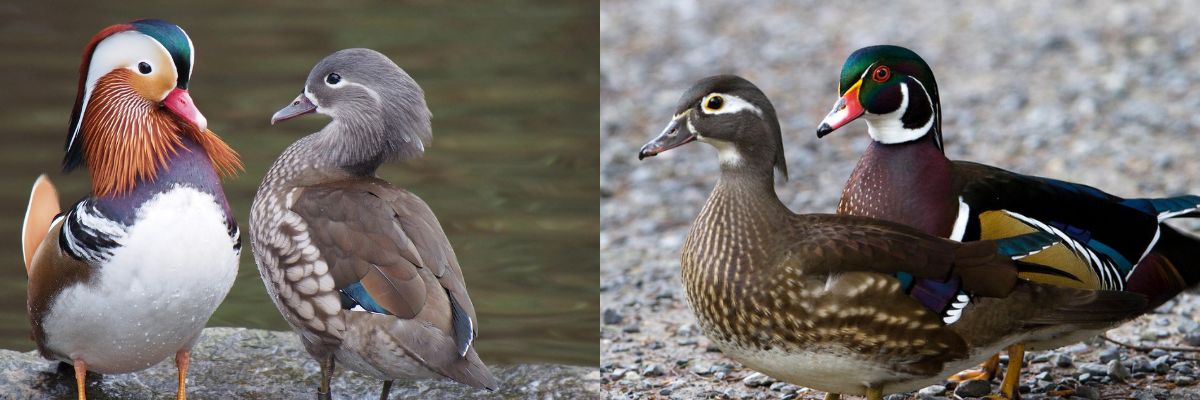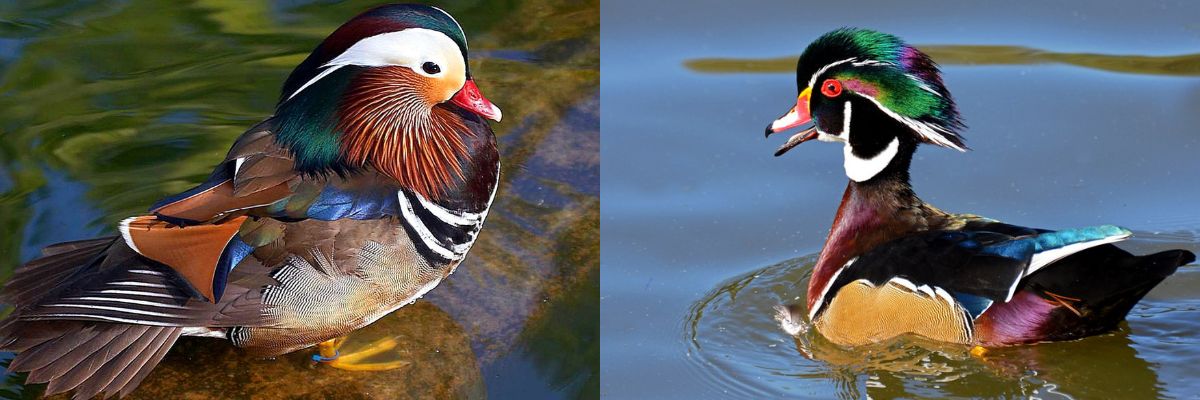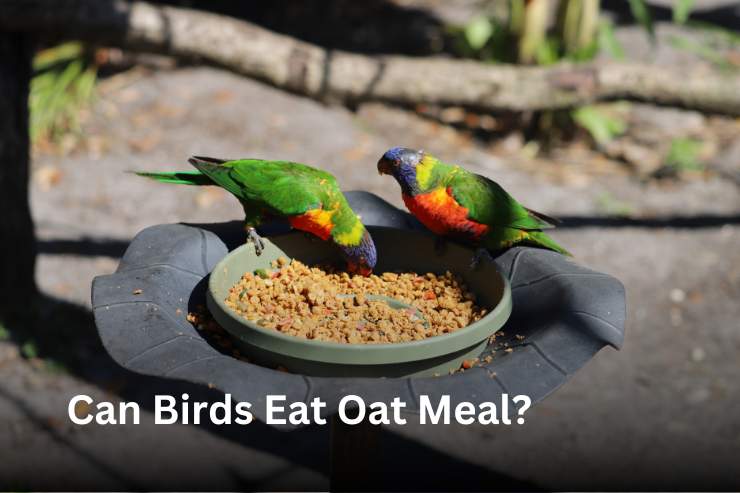Mandarin Duck Vs Wood Duck: Differences

Although the mandarin duck (Aix galericulata) and the wood duck (Aix sponsa) are part of the same duck family called Anatidae, they are not closely related.
The mandarin duck is originally from East Asia, whereas the wood duck resides in North America. Despite their different habitats, these ducks exhibit intriguing similarities in their behavior and appearance.

The plumage and behaviors of Mandarin ducks and wood ducks make them captivating waterfowl species. While they share some similarities, they also exhibit notable differences in various aspects of their lives.
In this article, we’ll explore these differences in terms of size and weight, the appearance of males and females, social behavior, nesting behavior, diet and foraging, and breeding habits.
Mandarin Duck Vs Wood Duck: Differences
| Aspect | Mandarin Duck | Wood Duck |
| Native Range | East Asia (China, Japan, Korea) | North America |
| Overall Appearance | Vivid and colorful plumage | Colorful with an iridescent sheen |
| Male Plumage | Striking orange, green, and blue | Vibrant iridescent colors |
| Female Plumage | Duller, brown with white eye-ring | Mottled brown and white |
| Size And Weight | Smaller, about 16-18 inches | Slightly larger, 18-21 inches |
| Body Shape | Slender and streamlined | Compact and chunky |
| Crest | Prominent crest on the head | Small crest on the head |
| Bill Color | Bright orange | Multicolored with red and yellow |
| Facial Pattern | White face with orange “whiskers” | White throat and eye-ring |
| Habitat | Ponds, rivers, and wetlands | Freshwater ponds and swamps |
| Diet | Omnivorous (plants, insects) | Omnivorous (seeds, insects) |
| Nesting | Tree cavities or nest boxes | Tree cavities or nest boxes |
| Nesting Behavior | Lays 8-12 eggs in a clutch | Lays 8-15 eggs in a clutch |
| Life Span | Around 5-10 years in the wild | Around 3-5 years in the wild |
Differences in Terms of Size and Weight
| Aspect | Mandarin Duck | Wood Duck |
| Size | Medium-sized duck | Medium-sized duck |
| Length (Male/Female) | 16-29 inches / 14-16 inches | 18-21 inches / 16-18 inches |
| Weight (Male/Female) | 1.2-1.7 pounds / 1-1.4 pounds | 1.2-1.4 pounds / 0.8-1 pound |
Both the Mandarin duck and the Wood duck fall into the medium-sized category among ducks, with males typically larger than females.
While there are slight variations in size and weight, the differences between these two species are subtle.
Appearance of Male and Female
Mandarin Duck
- Male: Mandarin drakes are known for their breathtaking, multicolored plumage. They have striking orange “sails” on their back, purple-blue “whiskers” extending from their eyes, and a red bill with a white tip.
- Female: Female Mandarin ducks, on the other hand, exhibit more subdued colors. They have a grayish-brown body with a white eye-ring and a less prominent crest.
Wood Duck
- Male: Male Wood ducks are recognized for their iridescent green and purple head, striking white throat, and intricate breeding plumage. Their eyes are adorned with distinctive red rings.
- Female: Female Wood ducks are not as colorful and have a brown, mottled appearance that helps them blend in while nesting..
The males of both species are celebrated for their stunning and vibrant plumage, often making them the focal point of a birdwatcher’s attention.

Source: Jon Sullivan
Source: Rodney Campbell
Social Behavior
Mandarin Duck:
Mandarin ducks form monogamous pairs during the breeding season. These pairs are often seen swimming together.
Mandarin ducks usually prefer to be alone and have their own designated space, compared to wood ducks who are more sociable and less territorial in nature.
Wood Duck:
Wood ducks engage in monogamous relationships during the mating season. These remarkable creatures exhibit intricate courtship rituals, which include head movements, preening, and vocal communication. Compared to mandarin ducks, wood ducks are known to be more sociable and enjoy the company of others.
They are known for their tree cavity nesting habits, which can lead to communal nesting, with multiple pairs nesting in the same area.
During the breeding season, both species form strong partnerships, emphasizing working together to care for their young..
Nesting Behavior
Mandarin Duck:
Mandarin ducks nest in tree cavities, but they may also use nest boxes if available. Their nests are lined with down feathers and concealed well to protect their eggs from predators.
The female mandarin duck lays a clutch of about 8 to 12 eggs.
Wood Duck:
Wood ducks are renowned for their tree cavity nesting behavior. They often choose natural tree hollows or nest boxes near water.
Female Wood ducks lay a clutch of eggs in the chosen cavity. Once the ducklings hatch, she encourages them to leap from the nest to the ground, sometimes from considerable heights.
The female mandarin duck lays a clutch of about 8 to 15 eggs.
Both species have a nesting behavior that involves using tree cavities, indicating their fondness for wooded habitats and their ability to adapt to nesting in such environments.
Diet and Foraging
Mandarin Duck:
Mandarin ducks consume both plant and animal-based food, their diet majorly includes water-based plants, seeds, bugs, and tiny water-dwelling creatures.
Their feeding actions involve pecking at the water’s surface or dipping their heads underwater to get to the submerged plants.
Wood Duck:
Wood ducks enjoy a diverse menu, including water plants, seeds, fruits, bugs, and tiny fish. They excel in dabbling and have the ability to dive for underwater plants and water insects.
Mandarin and Wood ducks can adjust their eating habits based on the availability of food.
Breeding Habits
Mandarin Duck:
Mandarin ducks typically breed in the spring and early summer. In East Asia, the mandarin duck breeds from February to April.
The male performs elaborate courtship displays to attract a mate, including head bobbing and vocalizations.
Wood Duck:
Wood ducks also breed in the spring, from March to June in North America. Mating pairs engage in intricate courtship displays, often involving synchronized movements and vocalizations.
Both species invest considerable effort into courtship rituals, reinforcing their commitment to raising the next generation.






